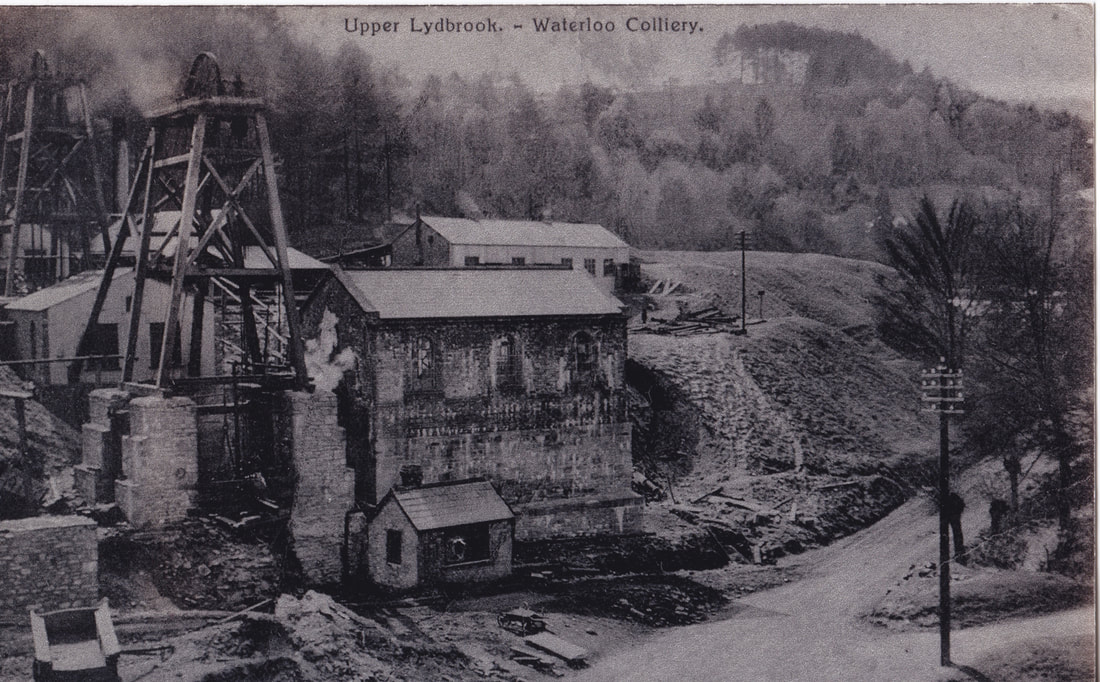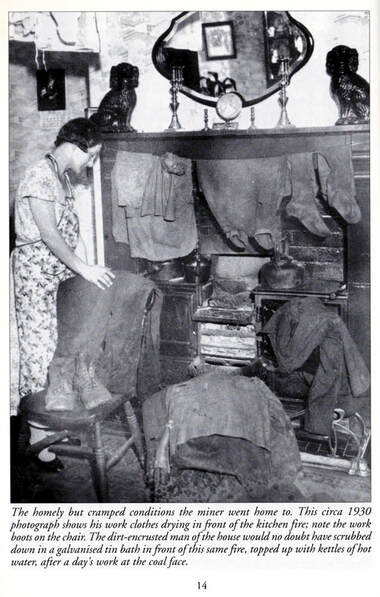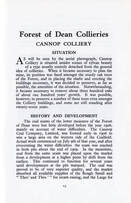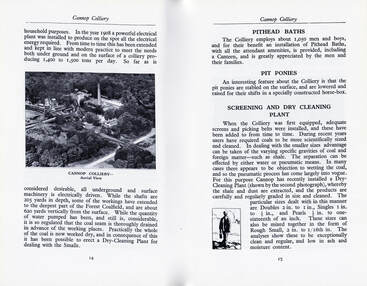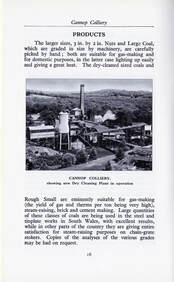Forest Mines, Miners and Mining
Resources for use in the classroom
Resources for use in the classroom
There are many excellent examples of descriptive or expository writing about mining in the Forest of Dean but they are disparate and often in books that are now out of print. This collection’s purpose is to draw together some of these extracts in order to provide you with a basic resource bank. These extracts can supplement local history projects, be used as guided reading texts, form the starting point for descriptive writing/poetry, i.e. be used right across the curriculum. We hope you find them useful...
Autobiography / Memoir / Personal Study
Door Minding and Hodding
from Son of the Forest (n.d.) by Billy Cann
Billy was born in 1923 at Bilson Green (in lower Cinderford). After briefly working at a Forestry plantation, then Cannop Chemical Works, and at Staunton Brickworks, he started work at Waterloo Colliery in Lydbrook.
To work in a mine you took on one job at a time, almost like an apprenticeship. A boy’s first job was door minding. These doors were big wooden affairs, used to divert air to other districts, and you opened them to let the empty carts go through and the full carts to return. It was boring but it got you used to the underground conditions, and after a few weeks I was moved to work on a parting, where the empty trucks (carts) were sent to the coal face by pit pony. My job was to couple the full carts up and, when ready, ring the bell and the haulage would take these to pit bottom. Each move you made was a little more in the pay packet […]
One job I would not do in the mines was a job called hodding […] the lad had to drag a box behind him by means of a harness, on his hands and knees, up to the man who in turn would fill the box with whatever he was digging out. The lad would then drag it back down to the end of the tunnel and into the roadway, then tip the box’s contents into a truck or tub. Needless to say, by the end of the shift, that lad wasn’t only tired, he was very sore as the harness dug into his body and his knees would be raw in no time. The medicine for this soreness was to pee in a tin and, each day, dab the sore areas with one’s own pee or ‘body water’ as it toughened up the skin.
© Billy Cann
from Son of the Forest (n.d.) by Billy Cann
Billy was born in 1923 at Bilson Green (in lower Cinderford). After briefly working at a Forestry plantation, then Cannop Chemical Works, and at Staunton Brickworks, he started work at Waterloo Colliery in Lydbrook.
To work in a mine you took on one job at a time, almost like an apprenticeship. A boy’s first job was door minding. These doors were big wooden affairs, used to divert air to other districts, and you opened them to let the empty carts go through and the full carts to return. It was boring but it got you used to the underground conditions, and after a few weeks I was moved to work on a parting, where the empty trucks (carts) were sent to the coal face by pit pony. My job was to couple the full carts up and, when ready, ring the bell and the haulage would take these to pit bottom. Each move you made was a little more in the pay packet […]
One job I would not do in the mines was a job called hodding […] the lad had to drag a box behind him by means of a harness, on his hands and knees, up to the man who in turn would fill the box with whatever he was digging out. The lad would then drag it back down to the end of the tunnel and into the roadway, then tip the box’s contents into a truck or tub. Needless to say, by the end of the shift, that lad wasn’t only tired, he was very sore as the harness dug into his body and his knees would be raw in no time. The medicine for this soreness was to pee in a tin and, each day, dab the sore areas with one’s own pee or ‘body water’ as it toughened up the skin.
© Billy Cann
Forest Miner (1980) by A. Marfell
This fantastic booklet is Alan Marfell’s personal memoir about the pits and working methods of the Forest of Dean. It gives a clear and detailed insight into the working practices of the time. Below is a short extract about Trafalgar Colliery, near Brierley:
I started work at Trafalgar Colliery, near Brierley in 1922, so I can only give details of the workings that were in use at that time. This pit closed down in 1925, due to the depression in the coal mining industry, but it was no means worked out.
The seams being worked were the house coal measures, some of the finest bituminous coal in the country. Thousands of tons are still there waiting to be got, and with modern machinery the hard hand-holing would be done with coal cutters, and what was known as ‘hodding’ would be done with conveyors.
This pit was the first pit in the world to have electric light underground, and the electric detonators were made at Smith’s Detonator Factory at Serridge Green, a ¼ mile from the pit top.
The coal was reached by two shafts 30 or 40 yards apart. One winding engine wound both shafts, coal coming up and empties going down. One shaft was the downcast, where fresh air went down into the workings. The other shaft had a kind of bonnet fitted over the tacklers which covered the top of the land pit, so there was very little air loss. The main upcast shaft was called Puzzle, as the pit had been driven up-hill to the surface and had had a fan and engine house installed on the other side of the tunnel at Serridge Green. It was right beside the Under- Manager’s house, called Puzzle House.
© A. Marfell
This fantastic booklet is Alan Marfell’s personal memoir about the pits and working methods of the Forest of Dean. It gives a clear and detailed insight into the working practices of the time. Below is a short extract about Trafalgar Colliery, near Brierley:
I started work at Trafalgar Colliery, near Brierley in 1922, so I can only give details of the workings that were in use at that time. This pit closed down in 1925, due to the depression in the coal mining industry, but it was no means worked out.
The seams being worked were the house coal measures, some of the finest bituminous coal in the country. Thousands of tons are still there waiting to be got, and with modern machinery the hard hand-holing would be done with coal cutters, and what was known as ‘hodding’ would be done with conveyors.
This pit was the first pit in the world to have electric light underground, and the electric detonators were made at Smith’s Detonator Factory at Serridge Green, a ¼ mile from the pit top.
The coal was reached by two shafts 30 or 40 yards apart. One winding engine wound both shafts, coal coming up and empties going down. One shaft was the downcast, where fresh air went down into the workings. The other shaft had a kind of bonnet fitted over the tacklers which covered the top of the land pit, so there was very little air loss. The main upcast shaft was called Puzzle, as the pit had been driven up-hill to the surface and had had a fan and engine house installed on the other side of the tunnel at Serridge Green. It was right beside the Under- Manager’s house, called Puzzle House.
© A. Marfell
Ideas for use in the classroom
A source of evidence for a local history project; guided reading text.
A source of evidence for a local history project; guided reading text.
Where I Belong (1993) by Joyce Latham
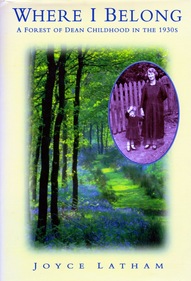
This is a treasure trove of stories and memories about growing up in the Forest. It also contains a fascinating description of the Union Pit disaster, in which her Uncle Jim was involved. The following extract is just a small part of a longer description of the events. (p71)
At the pit-head a huge crowd stood in silent prayer – wives, mothers, fathers, brothers and sisters, children, friends and neighbours. Men were frantically pumping night and day, and there was no shortage of volunteers to plunge down into that terrible place to wade waist-high in freezing, filthy water for hours on end in search of lost companions. After five days and nights of toil hopes of finding anyone alive had been all but exhausted, when above the noise of the water one of the rescue team heard a faint sound. Everyone held their breath as he called out in return – and almost cried with joy when a distant shout came back through the darkness. With renewed strength, the rescuers dug and burrowed their way in the direction of the call. The water was subsiding a little, thanks to the effort of the men on the pumps. Uncle Jim said it had risen to their chins, and he and his surviving mates had prayed together for God to have mercy on their souls until, as if by some miracle, the water level had begun to recede...
....The rescuers found three survivors out of the seven who had been entombed. Willing hands helped these weak, exhausted men on to stretchers, and bore them shoulder-high through the flood water and over rocks, timber and other debris, all in almost total darkness. It took them a long time to reach the cage at the shaft bottom, and Uncle Jim said he had never forgotten the patience and courage of those heroic miners. When at last they emerged into the September sunshine the anxious crowd burst spontaneously into a well-known hymn, ‘Praise God From Whom All Blessings Flow’. It must have been a highly emotional moment, mixed equally with joy and anguish, and Uncle Jim was not too far-gone to notice seven coffins lined neatly at the pit-head, three of which remained empty.
© Joyce Latham
Ideas for use in the classroom
Rewrite the pit disaster from a different person’s perspective, e.g. one of the waiting mothers, the mine owner; paint a scene from the story; a newspaper article including quotes from the rescued miners.
Rewrite the pit disaster from a different person’s perspective, e.g. one of the waiting mothers, the mine owner; paint a scene from the story; a newspaper article including quotes from the rescued miners.
You can find detailed history and images on the Union Pit disaster in Bixlade Valley: A Look Through the Ages (2009) by Dr Graham J. Field, chapter 2.
The Changing Forest (1962) by Dennis Potter
This thoughtful, personal study of the Forest, its people and culture contains the following description of a Forest pit. (p81)
These small pits are subject to inspection and national safety regulations, but in other ways remain ‘private’ – very much at the small workshop stage of the industrial revolution, rather as the ownership of land in the Forest, which belongs mainly to the Crown, remains at an even earlier stage. The pit is worked by the Gwilliam brothers – one tall and dignified, one stocky and ebullient, a good rugby player, and the other shy and impressively strong- is at Braceland, half a mile from Berry Hill and Ninewells. It has the cinematic appearance of a small prospector’s camp in the Rocky Mountains, for the working area is swallowed up by the trees, some of which have sagged wearily towards each other as a result of the steady eating away of rock and soil down beneath their roots. The land is unsteady here, with small gradients working against the slope, and a long stony fall to the Wye a mile to the West. Two tub-wide tunnels are driven into the bank, ultimately connecting with each other as they creep into the darkness: there is, therefore, an escape route and a freer flow of air. A small thread of railway emerges from each to converge again on a pile of damp, messy looking rubble which turns out to be small coal. There was mud everywhere, of a rich, oozy, squelchy kind. Props of timber and neat stacks of chunky logs lay in the foreground, an axe was stuck into a bigger log, and a cloud of most pure white wood smoke hung in the drooping branches of the tree which acts as a second roof above the small timber shack the brothers use as an office, planning centre, eating place and cloakroom.
© Dennis Potter
© Dennis Potter
Ideas for use in the classroom
Get pupils to write comprehension questions in response to reading the text.
Get pupils to write comprehension questions in response to reading the text.
Heavens Gate (1886) by Lawrence Severn (real name Ada M. Trotter)
This fascinating book contains lots of local detail. Trotter (whose father was a Forest mine owner) moved to Canada, and later the USA. She was a journalist, and a writer for the Girl’s Own Paper. This story depicts a Forest family who own shares in a local mine and their son who is searching for meaning in his life (p289).
“The cage is ready, maister,” said the foreman.
“All right then! Here thee, Billy Kear, give me a hond off this ‘um yeer stwon.”
Half a dozen arms seized and lift him to the ground, and, with a merry laugh, William went up to the cage. The mouth of the pit yawned dark and gloomy, and the cage creaked dismally. The foreman carefully assisted Dr. Herly to get in, and then the men took their places. William last of all, with one long look at the bright Forest world, jumped into his place, and bade the men cheerily “lower away.”
The descent in the cage in the Forest pits was not achieved with the evenness of modern appliances. The sensation caused by the movement was akin to sea-sickness, the mental emotion almost weird. The shaft was narrow; the clay walls streamed with water; the slight board, which stood between you and the yawning depth below, shivered and bent under your feet. No relief was gained by an upward look; for every moment made the pit’s mouth more distant until, at length, it was but a speck of light.
The cage has touched the bottom; spring out and peer into the darkness; stand aside, for a ghostly footfall comes upon the ear; some horses pass with slow, solemn march; heavy trams roll behind. They disappear in turn, then a candle, moulded in clay, is thrust in your hand – you are considered equipped for the lower world; its phantom glories are for your vision.
“All right then! Here thee, Billy Kear, give me a hond off this ‘um yeer stwon.”
Half a dozen arms seized and lift him to the ground, and, with a merry laugh, William went up to the cage. The mouth of the pit yawned dark and gloomy, and the cage creaked dismally. The foreman carefully assisted Dr. Herly to get in, and then the men took their places. William last of all, with one long look at the bright Forest world, jumped into his place, and bade the men cheerily “lower away.”
The descent in the cage in the Forest pits was not achieved with the evenness of modern appliances. The sensation caused by the movement was akin to sea-sickness, the mental emotion almost weird. The shaft was narrow; the clay walls streamed with water; the slight board, which stood between you and the yawning depth below, shivered and bent under your feet. No relief was gained by an upward look; for every moment made the pit’s mouth more distant until, at length, it was but a speck of light.
The cage has touched the bottom; spring out and peer into the darkness; stand aside, for a ghostly footfall comes upon the ear; some horses pass with slow, solemn march; heavy trams roll behind. They disappear in turn, then a candle, moulded in clay, is thrust in your hand – you are considered equipped for the lower world; its phantom glories are for your vision.
Ideas for use in the classroom
Use as an example of creating atmosphere in writing; use the extract as a story opening- plan, draft and write what happens next.
Use as an example of creating atmosphere in writing; use the extract as a story opening- plan, draft and write what happens next.
Non-fiction
Blood On Coal (1999) by Ralph Anstis
Ideas for use in the classroom
Source of evidence for history project; starting point/inspiration for descriptive writing/setting; write and answer questions to practise inference skills.
Source of evidence for history project; starting point/inspiration for descriptive writing/setting; write and answer questions to practise inference skills.
Fine Forest of Dean Coal
This promotional book by the Forest of Dean Colliery Owners’ Association is a small, informative booklet. It contains details and photographs of the larger collieries, as well as advertisements from local companies connected to the mining industry at the time.
This promotional book by the Forest of Dean Colliery Owners’ Association is a small, informative booklet. It contains details and photographs of the larger collieries, as well as advertisements from local companies connected to the mining industry at the time.
Ideas for use in the classroom
Sources of evidence for local history/mining project; non-chronological report about Forest of Dean mines.
Sources of evidence for local history/mining project; non-chronological report about Forest of Dean mines.
The Royal Forest of Dean Free Miners Association (1983)
by Free Miners Association
by Free Miners Association
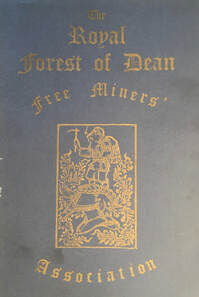
This interesting and varied booklet offers information about the Forest’s geology but also the connection and association between the Free Miners and Abenhall Church. In 2011 a new stained glass window was installed in the church that depicts traditional free mining methods.
More information about the window and church can be found HERE
The Free Miners Association also has its own website which chronicles the history of this unique custom from the first Crown records in 1244 to the present day.
More information about the window and church can be found HERE
The Free Miners Association also has its own website which chronicles the history of this unique custom from the first Crown records in 1244 to the present day.
Ideas for use in the classroom
Research and write about the ancient rights of the Free Miners; make prints of the Free Miner emblem using polystyrene blocks; design a stained glass window representing another aspect of the Forest of Dean, your school or something personal for your pupils.
Research and write about the ancient rights of the Free Miners; make prints of the Free Miner emblem using polystyrene blocks; design a stained glass window representing another aspect of the Forest of Dean, your school or something personal for your pupils.
Poetry
F. W. Harvey
This poem is by the Gloucestershire poet F. W. Harvey who lived in Yorkley. The poem is in F. W. Harvey: Collected Poems 1912-1957 (1983), p83. It also appears in The Last Deep Mine of the Dean (1988) by Maurice V Bent, p35 - a non-fiction book about the Northern United Colliery [with lots of photographs of the working and social life above and below ground at the pit]
This poem is by the Gloucestershire poet F. W. Harvey who lived in Yorkley. The poem is in F. W. Harvey: Collected Poems 1912-1957 (1983), p83. It also appears in The Last Deep Mine of the Dean (1988) by Maurice V Bent, p35 - a non-fiction book about the Northern United Colliery [with lots of photographs of the working and social life above and below ground at the pit]
|
(A sermon) Coal
I sing the dark poetic theme Of coal that’s ripped from out a seam (And every man is coal) And every cinder symbol of That dark creation of God’s love (Fire sleeping in his soul). Fire is (of soul) the blazing coal; Fire is (of coal) the sleeping soul; So man is made of coal. Colliers and coal conceal the glow Of sunrise kindled long ago And hidden in a hole. This forest old as we pretend Is young in years; and when we spend Amid its gold and green Our lives, what deem we of those trees, The countless, countless ancestries That countless suns have seen. |
For countless forests one by one Took the great life-giving sun Into their branch and bole And fell and died (as die we deem) Until they turn unto a seam Of hidden, black, hard coal. The ancient prisoned sunshine is A symbol of God’s mysteries For coal that seemeth dark As night; when raised with sweat and toil From its dark dungeon of the soil, Preserves its ancient spark. And collier- men are symbols of All souls that strive to show the love That lights a darkened world, Black bishops, gloomy deans of Dean, These show and symbolise, I ween A flag of faith unfurled. © P. W. Harvey |
Ideas for use in classroom
Guided reading text for analysis; a literary resource to compliment the teaching of rocks and soils (formation of coal).
Guided reading text for analysis; a literary resource to compliment the teaching of rocks and soils (formation of coal).
Forest Folk (no date) by Marina Lambert,
with illustrations and stories by W. B. Johns (p79).
This book contains many descriptions of Forest life, including life in a miner’s cottage.
This poem appears on p79:
with illustrations and stories by W. B. Johns (p79).
This book contains many descriptions of Forest life, including life in a miner’s cottage.
This poem appears on p79:
Haulier
Hooves of the great horse are plodding along
Even before the birds start to sing their song
Early morning mists muffle the sound
Of iron cart wheels turning on the ground
Horse’s breath like smoke on the frosty air
Lending an unearthly look to this trundling pair
The haulier, with his legs dangling over the shaft
A sack round his shoulders to keep out the draught
Follows the cart path track past the old ‘Flour Mill’,
Stopping at the spring to let the horse have its fill
Then travels on to the Princess Royal screens
Loading coal to take back round the village greens
At the miner’s cottage, ‘Whoa lad’, he’ll say
Climbing down to give the horse his big bag of hay
He shovels the coal, all shiny and black
In a pile by the gate, never carried in a sack,
Tickets handed over for the miner’s wife to sign
His allowance coal received for working down the mine,
These are memories fast fading away
Of when the Forest pits worked, each night and day.
© Marina Lambert
Hooves of the great horse are plodding along
Even before the birds start to sing their song
Early morning mists muffle the sound
Of iron cart wheels turning on the ground
Horse’s breath like smoke on the frosty air
Lending an unearthly look to this trundling pair
The haulier, with his legs dangling over the shaft
A sack round his shoulders to keep out the draught
Follows the cart path track past the old ‘Flour Mill’,
Stopping at the spring to let the horse have its fill
Then travels on to the Princess Royal screens
Loading coal to take back round the village greens
At the miner’s cottage, ‘Whoa lad’, he’ll say
Climbing down to give the horse his big bag of hay
He shovels the coal, all shiny and black
In a pile by the gate, never carried in a sack,
Tickets handed over for the miner’s wife to sign
His allowance coal received for working down the mine,
These are memories fast fading away
Of when the Forest pits worked, each night and day.
© Marina Lambert
COMMENTS
If you have found these resources useful or have any suggestions please let us know here...or get in touch via our contacts page
